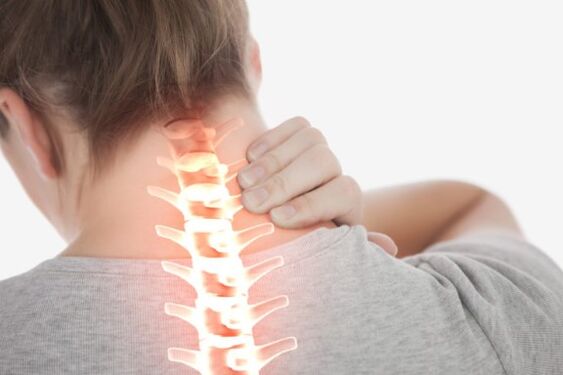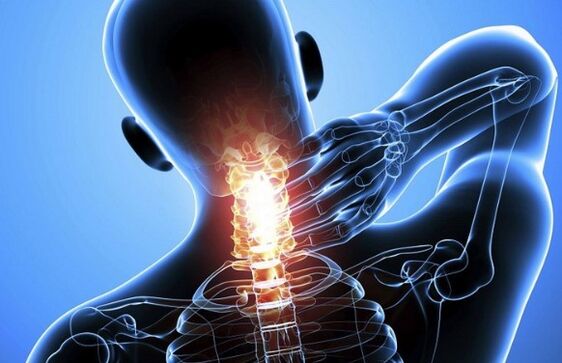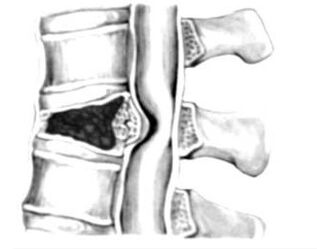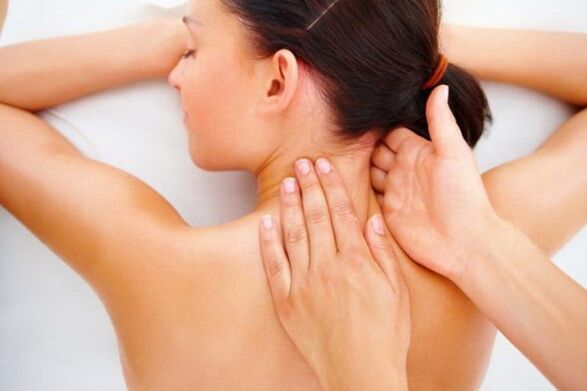Osteochondrosis is a complex of serious degenerative-dystrophic destruction of cartilage tissue located between vertebral vertebrae. In this pathological phenomenon, the discs themselves, their changes in height, bone tissue was damaged in the cervical region.Pathology has similar symptoms with some diseases. The main thing is to notice the first signals of the body on time and pass the diagnostics with the necessary treatment, otherwise osteochondrosis will begin to progress, cause migraines and blood disorders and blood disorders. Basically, pathology is developing in people who reduced motor activity. This is due to the fact that the exchange of mineral salts in the body is disrupted, which causes the thinning of the connective tissue as well as reducing strength.

Casual factors appearing a disease
The neck is the most desirable part of the body, therefore perceives a permanent burden, because it is obliged to keep your head in a certain position. Some factors can have a negative impact on this body area and forming inflammatory processes in body tissues.
The reasons for the development of pathological deviations in the vertebra of cervix are:
- disrespect for strength rules, which is why a set of excess weight;
- Functional change in the skeletal muscle system;
- hypodynamia;
- injury to the door or spinal column;
- Excess physical pressure on the spinal column;
- stress;
- Physical long-term voltage of cervical frame;
- heredity;
- Anomalies in bone development.
All these factors negatively affect the vertebrae of the cervical region, creating pressure, which leads to an involuntary reduction in smooth and skeletal muscles. Which leads to the formation of hemodiscitant processes, slow down the functions of metabolism, development of dysfunction and degenerative changes in the cartilage. The vertebrae start to deform, acquiring non-standard forms, and often cross the end of the spine.
Symptoms of the disease
The very initial phase of the pathological process is clearly visible in some signs.
- Cephalgic syndrome. It is formed during cerebral angiospasm, squeezing cerebrospinal cerebral nerves, as well as the background of involuntary intracranial hypertension. It spreads through the occipital part of the head, door, which affects the shoulder and upper limbs region. Cheese pain can look like a long-term increase in blood pressure (hypertension), an attack of angina pectoris, violating cerebral circulation and manifest in the form of paroxysmal, permanent or pulsating nature. Anxiety can be increased, mood swings, attention concentration observes, the person becomes irritable, touched;
- Dizziness occurs, the coordination of the movement is disturbed. Everything is accompanied by tinnitus, nausea, vomiting, appears disorientation. It is not always a sign of this pathology, because it can manifest as a result of the average or internal otitis media, heart disorders, cerebral angiospasm or damaged nerve cell function. Also, dizziness is often noticed with vestibular disorder;

Important!There are two types of dizziness. A log loudness, stunning, is difficult to be in an upright position with the unsystematic dizziness. But at the same time, objects that see not turn around. And with the systemic movement of all facilities, it is manifested, which indicates violations in the work of vestibular apparatus, visual perception, muscular cramps. This is a distinctive sign of a dizziness for osteochondrose.
- painful manifestations in the neck. The sensations of pain are localized not only in muscle tissues, but also in the shoulders, including upper limbs. The appearance of pain develops suddenly and lasts long and can have a short period. If the disease has not turned into relapse, then pain will pass pain after a while while the accompaniment of a slight specific sound (crumb) will be;
- Arterial hypertension. When I tighten nerve endings, a sharp jump in blood pressure appears. Therefore, if the increased pressure is observed for a long time, it is not a symptom of osteochondrose. High pressure in this disease is combined with cephalgia, pain aches in their hands, compressing breasts, cervix-brotherly back loses its sensitivity. The state of weakness, fatigue, lack of strength in the muscles of the upper limbs.
Table. Classification of osteochondrose of the cervical region.
| Phase | Characteristic |
|---|---|
| The lork door is a little smooth. The appearance of pain, intensifying as he moves his head. The occurrence of tense condition and weaknesses in the muscles of the lumbar region. | |
| There is a reduction in the size of fibrous and crisis formations, compressing nervous branches. The pain radiates in the shoulders, hands, is intensified when moving the door. Cephalgic syndrome, feeling fatigue, distractions, develops and performance. | |
| Feeling pain of permanent nature in the upper extremities, cervical and shoulder. There is muscle weakness, stiffness of limbs. Intervertebral disc kila is formed. The neck is inactive, vertigo appears. | |
| Vlasna and crossing formations were destroyed. Connection fibers replace the destroyed cartilage. The destruction process can simultaneously affect more than one spine. The patient is completely disoriented, pain and vertigo increase. |
What is the danger of illness?

Pathology harms the whole human body. In addition to osteochondrose, blood vessels are firmly clenched, leading to diskulatory-encephalopathy, are caused by cephalic syndrome, caused by heart rate pathologies, visual, respiratory systems, concentration and coordination process.
The disease tends to cause:
- various brain pathologies;
- Number of vastibular, vascular, vegetative nature disorders;
- Acute breach of Kiran China with the development of ischemia or bleeding (spinal shock).
Diagnostics
Ways of diagnosing breaches of interfaced discs.
- Radiography. It is not effective enough in the last stage of the disease.
- Magnetic resonance tomography (MRI). Research mode, which carries detailed information on the presence of deviation, bone pathology, bonding tissues, whether there is any hernia, with clarification of its size, location and growth.
- Computer tomography using contrast. Allows you to determine pathology in vertebral. Inability in such a study is the impossibility of determining the presence of the compression of the spinal cord.
- Ultrasonic Dopplerography. The efficiency of this method is to determine the reduction of blood circulation through blood vessels.
Features of treatment
In the treatment of osteochondrose, the cervical region are based on the degree of disease, its characteristic clinical events and form. Treatment can be performed as:
- Neurgic therapy, whose purpose is the removal of symptoms, manifestation of the disease to mitigate the patient's condition that use drugs and physiotherapy, therapeutic exercises, massage;
- Surgical intervention;
- Combination therapy. In this method, surgical intervention is performed with further treatment of medicines.

After diagnostic examination, the specialist makes a final diagnosis and prescribes the required treatment depending on the clinical picture of the disease. Basically, if the disease is in a phase that does not require surgical surgery, a complex therapy is prescribed, which includes taking medications, the performance of therapeutic exercises and the passage of the greasing exchange rate.
Medications
The doctor prescribes medications aimed at removing pain symptoms and muscle tension, restoring cartilage tissue, renewing the body with a vitamin mineral complex, injection, fat.
Therapy Physical Culture (Exercise Therapy)
Medical physical education is prescribed to restore blood circulation in the cervical region. The movements should not be sharp, with excessive rotation or head bending. It is necessary to mimic the listed movements. Exercises are made for more than two minutes. The exercise treatment complex includes the heads of the head forward and backwards, without performing action to the end.
Basic exercises used to treat osteochondrose.
- Pose "Lying" on the stomach is accepted. The hands rest on the floor, and the head and Torso get up. The back stays straight. It is necessary to be in this position for about two minutes in 2-3 approaches.
- Pose "Lying" on the stomach is accepted. Hands stretch along the body. The head heads are made from the right and left, trying to touch the floor with your ear. 6-7 accesses for each side.
- Pose "sitting" is accepted. In addition to inhalation, the slope is unfolded, while trying to spread to the chest. When you exhale, it was made to return to your original position, with a light tilt of your head back. Out of 10-15 access are performed.
- In the position "sitting", palms of the hand is applied to the forehead, while moving movement. The head reaches both the palms, creating the effect of resistance. 2-3 accesses of 30 seconds.
- Circular head movementsperformed very carefully and slowly on the right side and left. Ten movements are performed in each direction, avoiding dizziness.
Therapeutic massage
In the treatment of osteochondrose, the specialist makes a massage in the cervical region, the surrounding environment and upper back. This procedure must be performed in a false position to make the patient's body relax relax.
The main techniques of therapeutic massage:
- Caress- The technique in which the massive arm slides along the skin with a low degree of pressure, grasping the surface of the base of the head and switches to the upper back.
- Sty- technique during which the stronger impact on the skin, subcutaneous tissue and the surface layer of the muscles are performed. The skin of the skin with your fingers carefully occurs, bypassing the peristoran fabric.
- Triturization- It consists in moving and stretching tissues in various directions for heating the skin and blood flow to the district region.
- Digging- The hardest technique that affects the deep muscle tissue. It is performed only about the recommendation of doctors, with caution, as it can lead to the complication of the disease.

Physiotherapy treatment
For the treatment of pathology of the intervertebral discs of the Cervical region, physiotherapy is prescribed.
- Medical electrophoresis-Fiziotherapy ultrasonic procedure performed under sinusoid modulated current.
- Laser therapy- This is a physiotherapy method that activates blood circulation, eliminates the inflammatory process, reducing pain. Laser therapy is carried out for improving blood flow.
- Magnetotherapy- One of the methods based on the treatment of magnetic field exposure, with the influence of the removal of the tissue edema and the pain is removed.
- Ultrasonic therapy- The treatment allows you to relieve pain, inflammatory process, with the improvement of circulation in the blood.
Traditional medicine in the treatment of osteochondrose of cervix
Folk methods for the treatment of osteochondrose will not work. This is due to the fact that these methods are able to temporarily alleviate symptoms, but not to solve the main problem - initial destructive effect in the spinal column. At home the plant components can be used as a support complex to the main therapy treatment founded by the doctor.
For pain in the Grlić Matica region, you can use:
- Flying leaves (treated with boiling water, applied to the focus of pain);
- Raw potatoes and honey (potatoes are rubbed until it is formed, rigid, mixed with honey in equal proportions and applied to the place of inflammation at least once a week);
- Mustard, paprika patch and rubbing alcohol (used for local irritating, increased blood circulation and pain removal).

Preventive measures
In order to prevent one of the dangerous diseases, it is necessary to respect certain rules for their whole life. After the right way of life, it can be prevented from many diseases. However, there are situations when the disease is inherited, and then it is worth careful to your health. Food nutrition enriched with vitamins and minerals, as well as moderate physical activities will help maintain the body, and even stop the development of the initial disease.
Doctor's recommendations to help prevent disease occurring:
- Take an active lifestyle, deal with swimming;
- Follow proper diet;
- Eat food with calcium, magnesium (seafood, legumes, dairy products, greenery);
- Daily make physical heat, especially if the work is connected to a permanent seated position;
- Use special orthopedic cushions and mattress to sleep.
At any age, with osteochondrose, it is worth regularly implementing the body testing, as well as the implementation of therapeutic physical culture with ordinary massage, and then with disease you can live long and with comfort.


















